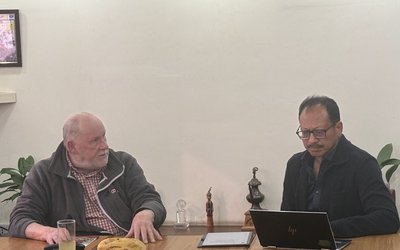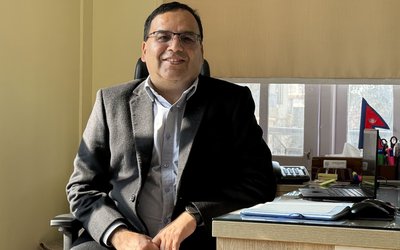More on Interview





DIGP and outgoing chief of Metropolitan Traffic Police Directorate (MTPD) BIGYAN RAJ SHARMA has made several improvements in the traffic management of Kathmandu Valley. In his seven months at MTDP, DIG Sharma, former national soccer player of Nepal, showed he had a vision to manage the traffic problems in the valley. Born in Tripureshwor, heart of Kathmandu, Sharma still remembers playing football and marble at the main streets during his childhood.However, the roads are now so congested that it is difficult for people to even cross them. Young police officer Sharma, who has clear goals, commitment and capability, spoke to New Spotlight on various issues. Excerpts:
The valley’s traffic management seems to have a lot of problems. Who enforces the rules?
The Department of Transport Management and the Traffic Police both have the authority to enforce the Transport Act. However, the department is busy in internal management and only the traffic police is enforcing the law on the road.
If a person violates the traffic rule, how much can a police impose as fine?
The range of the fine is from Rs. 25.00 to Rs. 200.00. The Traffic Police needs support if it wants to fine more than this. We cannot collect the amount of fines, it is collected by the person from the Department of Traffic Management.
How do you view the general awareness level of people on the roads?
It is getting better. People are now conscious that they will be fined in case of violation of law and regulation. This is a major achievement.
How do you look at the institutional capability of the Metropolitan Traffic Police Directorate?
I agree that the institution needs to be governed institutionally, not by an individual. A person like me can come and go, but it is the institutional capability that is a matter of concern for all times. I have introduced some new concepts like Traffic FM station, which will help to generate awareness as well as disseminate information to the public. Nobody can stop it now.
What are your experiences working as the chief of MTPD?
It is somehow difficult to work in a situation where one has to start the work from scrap and inadequate infrastructure. There is the need to make a lot of efforts to institutionalize the whole mechanism.
What other mechanisms have you used to disseminate the information?
We have an account on Facebook. This will set the stage for public debate on effective traffic management by solving longstanding problems of traffic jams, road accidents and rule violations.
One can log on to traffic.nepalpolice.gov.np to get connected with MTPD to lodge complaints, give feedbacks and suggestions. The persons who feel odd to meet traffic cops in person will benefit from the Facebook link.
Why did you realize the need of Facebook account?
We felt the need to create a Facebook account as a social network has become a tool for people irrespective of their race, sex and age. MTPD has used the network to make announcements and disseminate news like road accidents, traffic jams and rallies, among others. Traffic cops said they were wary of Facebook users who could send hoaxes. We are also doing groundwork to introduce e-banking system for traffic violators to pay fines. It will discourage the trend of offering and asking for bribe. A traffic violator can deposit the fine in a bank and come to MTPD with the voucher to claim the driving license.
How do you view the traffic problems of the valley?
It is in a horrible state as the length of road is inadequate for such a large number of vehicles to ply. Along with traffic congestion, the number of road accidents is also alarmingly high. The normal speed of vehicles during the hours is less than 5 kilometers an hour. This increases the incidents of traffic jams.
If the average speed is too slow, why is the number of accidents increasing?
This seems like a contradiction. The reality is that an overwhelming number of accidents occurred due to high speed. The speed is slow in core city areas but the ratio of accidents is higher in the ring road and Tinkune-Surya Binayak road where vehicles often run in high speed.
What do you suggest to reduce road accidents and traffic congestions?
To manage the traffic congestion, there is the need to improve the road infrastructure, including the construction of fly overs, permanent parking places, road marks and traffic lights. Remove the slow moving and old vehicles plying on the roads. There is also the need to open corridors to divert the vehicle pressure from the main roads. Increasing traffic awareness can reduce the present rate of road accidents drastically. Most of the accidents occurred due to lack of knowledge about the road signs, high speed and lane discipline.
Who are the violators of traffic rules?
It is interesting that most of the violators are literate and educated persons having private cars and motorbikes. I have not seen poor people violating road rules.
What do you suggest to improve road safety?
I would like to suggest investing more money in improving the road infrastructure like fly over and roads to increase the road safety. There is also the need to improve the mass transport system. Once a man gets casualty, it is painful in terms of family and financial terms. I think there is the need to empower the enforcement agency.
How do you look at the existing license system?
I think it should come under the police. Now the problem is that police enforce the law and other government department issues the license. It is very difficult to acquire license in other parts of the world, as there are several tests one needs to give. Our system needs to improve. There is need to test skills in real places like on roads.
Which factors do you see as the most sensitive?
My heart breaks when I see the death of young people in road accidents. It hurts me a lot to see the death of Nepal’s future generation and strength. According to our data, an overwhelming number of young people get killed in the accidents, that is, between 20 and 30. I read the news that three young students of class 12 were killed in a road accident before my posting to traffic. That also encouraged me to take some drastic measures. As a responsible officer of Nepal Police, this is my duty to assure security to all the citizens.







